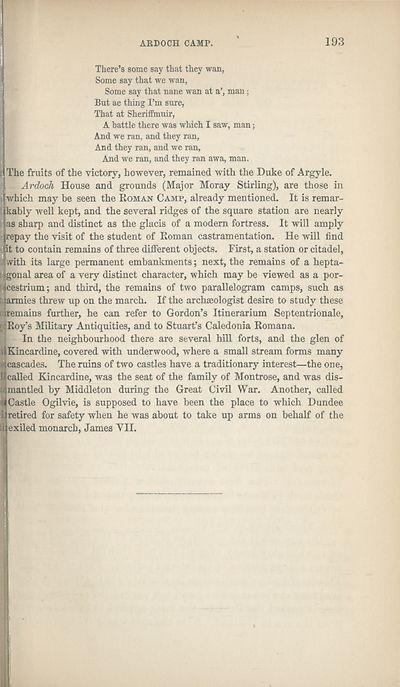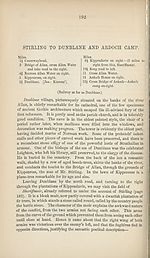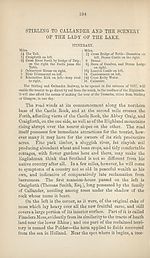Download files
Complete book:
Individual page:
Thumbnail gallery: Grid view | List view

AEDOCH CAMP.
193
There’s some say that they wan,
Some say that we wan.
Some say that nane wan at a’, man;
But ae thing I’m sure,
That at Sheriffmuir,
A battle there was which I saw, man;
And we ran, and they ran,
And they ran, and we ran,
And we ran, and they ran awa, man.
The fruits of the victory, however, remained with the Duke of Argyle.
Ardoch House and grounds (Major Moray Stirling), are those in
which may be seen the Roman Camp, already mentioned. It is remar¬
kably well kept, and the several ridges of the square station are nearly
as sharp and distinct as the glacis of a modem fortress. It will amply
repay the visit of the student of Roman castramentation. He will find
it to contain remains of three different objects. First, a station or citadel.
With its large permanent embankments; next, the remains of a hepta-
gonal area of a very distinct character, which may be viewed as a por-
cestrium; and third, the remains of two parallelogram camps, such as
armies threw up on the march. If the archaeologist desire to study these
temains further, he can refer to Gordon’s Itinerarium Septentrionale,
Roy’s Military Antiquities, and to Stuart’s Caledonia Romana.
In the neighbourhood there are several hill forts, and the glen of
Kincardine, covered with underwood, where a small stream forms many
cascades. The ruins of two castles have a traditionary interest—the one,
called Kincardine, was the seat of the family of Montrose, and was dis¬
mantled by Middleton during the Great Civil War. Another, called
Castle Ogilvie, is supposed to have been the place to which Dundee
retired for safety when he was about to take up arms on behalf of the
exiled monarch, James VII.
193
There’s some say that they wan,
Some say that we wan.
Some say that nane wan at a’, man;
But ae thing I’m sure,
That at Sheriffmuir,
A battle there was which I saw, man;
And we ran, and they ran,
And they ran, and we ran,
And we ran, and they ran awa, man.
The fruits of the victory, however, remained with the Duke of Argyle.
Ardoch House and grounds (Major Moray Stirling), are those in
which may be seen the Roman Camp, already mentioned. It is remar¬
kably well kept, and the several ridges of the square station are nearly
as sharp and distinct as the glacis of a modem fortress. It will amply
repay the visit of the student of Roman castramentation. He will find
it to contain remains of three different objects. First, a station or citadel.
With its large permanent embankments; next, the remains of a hepta-
gonal area of a very distinct character, which may be viewed as a por-
cestrium; and third, the remains of two parallelogram camps, such as
armies threw up on the march. If the archaeologist desire to study these
temains further, he can refer to Gordon’s Itinerarium Septentrionale,
Roy’s Military Antiquities, and to Stuart’s Caledonia Romana.
In the neighbourhood there are several hill forts, and the glen of
Kincardine, covered with underwood, where a small stream forms many
cascades. The ruins of two castles have a traditionary interest—the one,
called Kincardine, was the seat of the family of Montrose, and was dis¬
mantled by Middleton during the Great Civil War. Another, called
Castle Ogilvie, is supposed to have been the place to which Dundee
retired for safety when he was about to take up arms on behalf of the
exiled monarch, James VII.
Set display mode to:
![]() Universal Viewer |
Universal Viewer | ![]() Mirador |
Large image | Transcription
Mirador |
Large image | Transcription
| Antiquarian books of Scotland > Scotland/Scots > Black's picturesque tourist of Scotland > (273) |
|---|
| Permanent URL | https://digital.nls.uk/130031466 |
|---|
| Description | Thousands of printed books from the Antiquarian Books of Scotland collection which dates from 1641 to the 1980s. The collection consists of 14,800 books which were published in Scotland or have a Scottish connection, e.g. through the author, printer or owner. Subjects covered include sport, education, diseases, adventure, occupations, Jacobites, politics and religion. Among the 29 languages represented are English, Gaelic, Italian, French, Russian and Swedish. |
|---|

